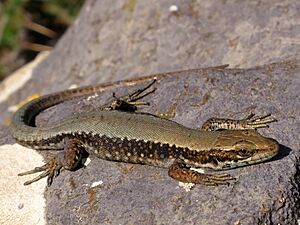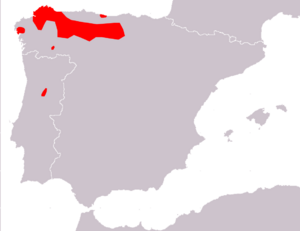Iberian rock lizard facts for kids
Quick facts for kids Iberian rock lizard |
|
|---|---|
 |
|
| Conservation status | |
| Scientific classification | |
| Genus: |
Iberolacerta
|
| Species: |
monticola
|
 |
|
| Synonyms | |
|
|
The Iberian rock lizard (Iberolacerta monticola) is a type of lizard that lives only in Portugal and Spain. It belongs to the Lacertidae family of lizards. These lizards make their homes in mountain forests, bushy areas, near rivers, and in rocky areas. Sadly, their homes are disappearing, which means this lizard is facing a threat.
Contents
About the Iberian Rock Lizard
The Iberian rock lizard is a small creature. It measures about 8 centimeters (3 inches) from its nose to the start of its tail. Its tail is long and thin, about twice as long as its body! This lizard has a somewhat flat body and short, delicate legs.
Its color can be different depending on where it lives. Generally, it's a light brown or green. It might have stripes or rows of dots and small patches along its body. Unlike some other lizards, the stripe along its back is not usually darker than other markings.
Most Iberian rock lizards have a bright green belly. Young lizards might even have blue tails! As they get older, their bellies turn green. Their upper bodies also slowly become green as they age.
Where They Live and Their Home
The Iberian rock lizard is found in the Cantabrian Mountains and in Galicia in northwest Spain. You can also find them in the Sierra de Gredos in Central Spain and the Serra da Estrela in central Portugal.
In Galicia, they can live at sea level. But in other places, they usually live high up in the mountains. They are often found at altitudes of 1,000 meters (about 3,300 feet) and can live as high as 2,000 meters (about 6,600 feet) above sea level.
These lizards like damp spots among rocks in scrubby areas. In Galicia, they also live in low-level woodlands. They are good at handling cold weather. You often find them above the tree line, in places where winters are long and summers are wet or misty. If their home overlaps with the common wall lizard (Podarcis muralis), the Iberian rock lizard tends to live at higher altitudes and climb higher on cliffs.
Reproduction and Life Cycle
Male Iberian rock lizards often protect their territory during the breeding season. The female lizards lay their eggs under stones or in other hidden spots. These eggs are about 10 to 15 millimeters (0.4 to 0.6 inches) long.
The young lizards hatch from their eggs after about six to eight weeks. They grow up and become ready to have their own babies in about two years. A study in 2008 found that female lizards tend to mate with males who have more green on their bodies.
Status and Protection
The Iberian rock lizard is listed as "vulnerable" on the IUCN Red List of Threatened Species. This means they are at risk of becoming endangered if things don't change.
Their population is threatened because their living areas are becoming separated. Also, activities like farming, cutting down trees, and tourism are harming their natural homes. In some places where conditions are just right, these lizards can be quite common. However, in other areas, their numbers are getting smaller.
Subspecies
There are three recognized types of Iberolacerta monticola:
- Iberolacerta monticola astur Arribas et al., 2014
- Iberolacerta monticola cantabrica (Mertens, 1929)
- Iberolacerta monticola monticola (Boulenger, 1905)


